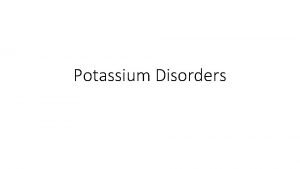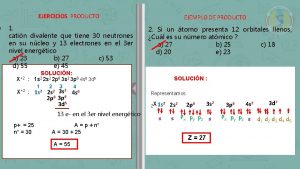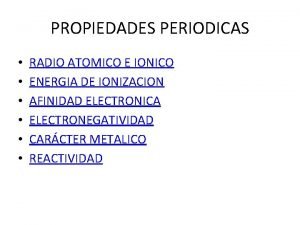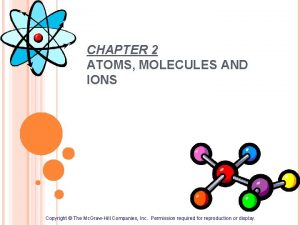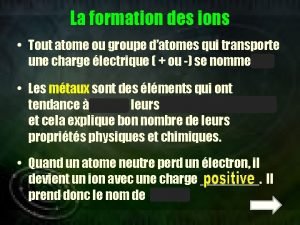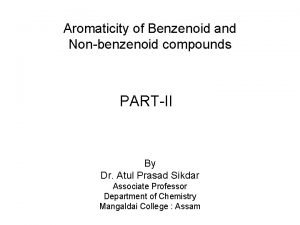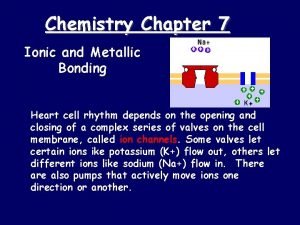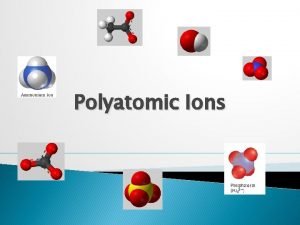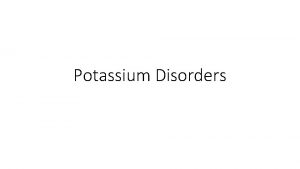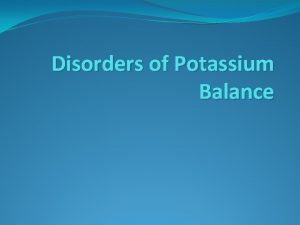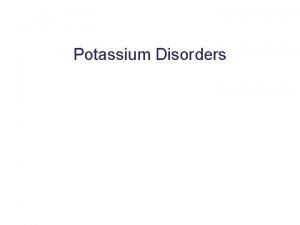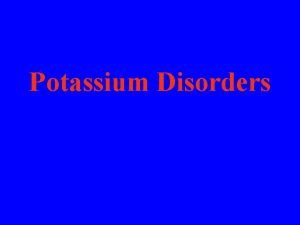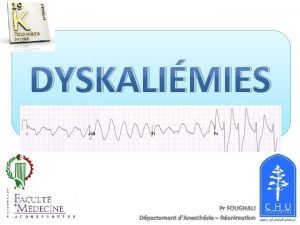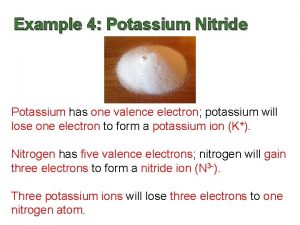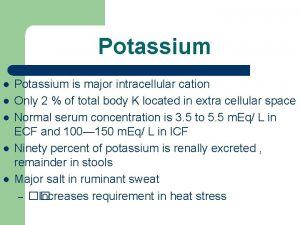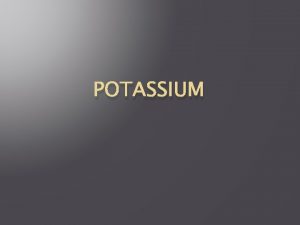Potassium Disorders Hypekalemia Potassium is mainly an cation

















- Slides: 17

Potassium Disorders

Hypekalemia • Potassium is mainly an _______ cation ? • What Is the normal range of potassium ? • How does hyperkalemia manifest clinically ? • What are the EGC changes associated with hyprekalemia ? • How is hyperkalemia acutely managed ? • How do you approach a case of hyperkalemia ?

• Normal range of serum potassium is 3. 5 -5. 3 m. Eq/L • true hyperkalemia manifests clinically as : Clinical presentation : • muscle and cardiac dysfunction • muscular symptoms • myalgias • muscle paralysis • chest pain • cardiac symptoms • arrhythmias and palpitations • nausea and vomiting • parasthesias

ECG changes • 1. Tall 'tented' T waves

2 - P wave changes Worsening hyperkalemia is associated with progressive flattening of P waves, prolongation of the PR interval (PR interval > 200 ms) and eventually disappearance of P waves. Bradycardia is common and AV block may complicate hyperkalemia.

3 -Broad QRS complexes • As serum K+ levels rise the QRS complex becomes wider eventually passing the upper limit of normal. At least think of hyperkalemia if you see this combination of wide QRS complexes and tall T waves.

4 -Development of a sine wave pattern • As K+ levels rise further, the situation is becoming critical. The combination of broadening QRS complexes and tall T waves produces a sine wave pattern on the ECG readout. Cardiovascular collapse and death are imminent.

5 - Ventricular fibrillation • The end game for untreated hyperkalemia is chaotic depolarisation of ventricular myocardium: ventricular fibrillation. No cardiac output is present. This situation is not compatible with life.


Acute management of hyperkalemia 1. Check for ECG CHANGES , if non , consider lab error , repeat sample without tourniquet , Otherwise , in the presence of symptoms , ECG changes or critically high potassium do the following 1. ABC…s 2. Place on continuous ECG monitor 3. Stabilize the myocardium by _______? 4. Induce trans-cellular sift by_______? 5. Rid the body of excess potassium by _______? 6. Treat the underlying cause


1 -IV calcium is indicated when the serum potassium is >6. 5 m. Eq/L regardless of whether ECG changes are present. 6 Given their poor sensitivity and specificity, ECG changes should not be used as diagnostic criteria for treatment of hyperkalemia. 7 The immediate goal of acute management in hyperkalemia is the stabilization of the membrane potential, which is often done with IV calcium. Calcium antagonizes the effects of hyperkalemia through effects on the threshold potential and the speed of impulse propagation at the cellular level. IV calcium can be given as 10 m. L of a 10% calcium gluconate solution over 2 to 3 minutes 2 -Insulin: Insulin accelerates the intracellular movement of potassium into muscle cells by binding to its receptor on skeletal muscle. Once this occurs, the abundance and activity of sodium-potassium adenosine triphosphatase (Na+/K+-ATPase) and glucose transporter on the cell membrane increase through independent signaling pathways. The most commonly recommended regimen is a bolus injection of short-acting insulin. If the blood glucose is <250 mg/d. L, 25 g of glucose should also be given (50 m. L of a 50% solution) to offset hypoglycemia due to insulin administration

3 - Sodium bicarbonate works to shift potassium intracellularly but is not considered first-line management of hyperkalemia due to controversial data regarding efficacy and safety concerns. Boluses of 1 m. L/kg of sodium bicarbonate 8. 4% solution have been suggested. Studies have shown that sodium bicarbonate was not able to decrease serum potassium significantly or rapidly, with onset of action potentially taking hours. 4 - Albuterol inhalation can be considered in nonacute situations to lower potassium. Albuterol stimulates Na+/K+-ATPase, which results in intracellular shift of potas-sium. Use of albuterol has been shown to decrease serum potassium levels by 0. 3 to 0. 6 m. Eq/L within 30 minutes; the decrease lasts for at least 2 hours.

• 5 - Diuretics : In patients with adequate kidney function, loop diuretics (e. g. , furosemide and bumetanide) in combination with thiazide diuretics can be used for the excretion of potassium. Onset of action is 15 to 60 minutes. However, it should be noted that although diuretic-induced volume depletion can lead to decreased distal nephron flow and reduced potassium excretion, volume-expanded patients will benefit from diuresis. • 6 - kayexalate or SPS is a cation-exchange polymer that exchanges sodium for potassium, in addition to other cations such as calcium, ammonium, and magnesium. SPS also contains a considerable amount of sodium content and should be used cautiously in patients with concomitant conditions such as congestive heart failure, edema, and severe hypertension.

it may be given as 15 to 30 g by mouth with cathartics (most commonly sorbitol) or as an enema. The rectal dose is 30 to 50 g but has been found to be less effective compared to an equivalent dose administered orally. What is the most important side effect of such a medication ? 6 - heamodyalisis

Causes of hyperkalemia- Approach ?

 Hypekalemia
Hypekalemia Configuracion electronica de un cation divalente
Configuracion electronica de un cation divalente Como se forma un cation
Como se forma un cation Cs+ ion name
Cs+ ion name Cation
Cation Elution定義
Elution定義 Cation jokes
Cation jokes Charge of ion
Charge of ion Cation polyatomic ions
Cation polyatomic ions Saneamento
Saneamento Benzenoid and non benzenoid
Benzenoid and non benzenoid Ammonium sulfate cation and anion
Ammonium sulfate cation and anion Polyatomic cation example
Polyatomic cation example Anion game
Anion game Massa atomica e massa molecular
Massa atomica e massa molecular Rayon de bohr
Rayon de bohr Cation identification
Cation identification Hbr cation and anion
Hbr cation and anion
